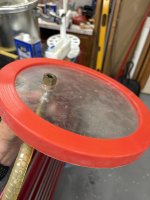Edit: Links to a glass lid supplier are near the end of this post. - Dave
Although many, many members are successful with plastic lids, even really good ones still scare me to death.
My first vacuum chamber was a stainless steel pot with an Acrylic (Plexiglass) lid. There was a hole drilled through it for the plumbing to go through (supply/exhaust, gauge, etc.). On my second use the lid imploded. In addition to the big "Bang!", It knocked my vacuum pump off the table, busted the vacuum gauge, and splashed Cactus Juice on the floor, on my pump, and on a bunch of other stuff. The experience almost soured me completely on home stabilizing.
When I got up enough nerve to give it another try, I replaced the imploded lid with one I made from Lexan (polycarbonate). It was still plastic and I still drilled a hole through it for plumbing, but Lexan it is much tougher and a lot less brittle so it can withstand the vacuum more. I did re-use the red silicone gasket though. After a few uses though it looked like the inside surface was getting those little microcracks as someone mentioned. Fearing another implosion I decided I needed something even more robust.
What I wound up with was a tempered glass lid with no holes drilled in it. To get the plumbing into the chamber, I drilled a hole near the top of the stainless steel pot. It is a much better and safer arrangement since holes drilled into plastics are usually inherent points of weakness.
After the whole ordeal, I'm still nervous when I use the thing, but at least I am comfortable enough to be in the same room with it when it is running. I also wasted a lot of time, money, and effort buying a thick sheet of Lexan and cutting it to size for the intermediate version. I wish I would have saved myself the money and grief and just bought the round tempered glass one to start with.
This is why I highly recommend replacing it with a glass lid. I ordered mine from
BVV (Building Vision and Variety). Mine was
10.75-inches by 3/4 inches thick and was manufactured by "Glass Vac". The company sells all kinds of scientific lab type equipment. - Dave

